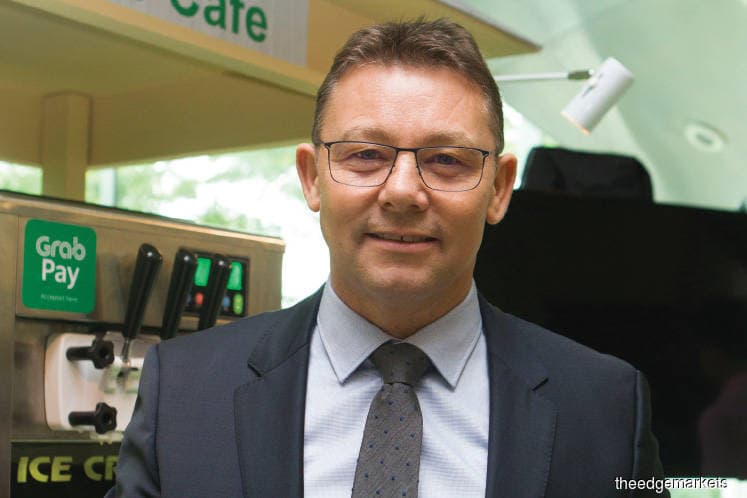
This article first appeared in The Edge Financial Daily on December 11, 2017
KUALA LUMPUR: Southeast Asia’s largest ride-hailing app operator Grab Inc is optimistic its e-wallet service, GrabPay, will see exponential growth, following the success of its ride-hailing app here.
Grab’s country head for Malaysia, Sean Goh, told The Edge Financial Daily that GrabPay is a huge opportunity for the company, although the adoption of new technology can be slow in Malaysia, but there have been exceptions to this.
Malaysia embraced Grab’s ride-hailing app readily, said Goh. “If you look at e-hailing adoption when we started in 2012, Malaysia was one of the fastest in the region, and greater than many parts of the world,” he said.
Grab, which commands more than 72% of the private vehicle-hailing market in Malaysia, obtained the licence to operate its digital money service from Bank Negara Malaysia (BNM) on Nov 13, which it will be rolling out in stages in the first or second quarter of 2018.
GrabPay uses a similar payment model featuring the mobile wallet and peer-to-peer fund transfer that was launched in Singapore, which was a boon in hawker centres in November.
It is an extension or expansion of the options for consumers to pay or buy things from GrabPay merchants with quick response (QR) codes, and transfer money or credit between users, from its current transportation service.
According to BNM, cash handling and services cost the banking industry RM1.8 billion a year and electronic-based payments may result in savings of up to 1% of a country’s economy due to lower retail payment cost versus cash transactions.
Goh also said adoption of other forms of digital payments may be slow because of concerns like fraud and safety. Even credit card payments are not necessarily the most seamless, he said.
“That is why we see a huge opportunity [for GrabPay], because the use of cash is still more prevalent. About 91% of Malaysians use cash for payments, including merchants.
“[So if we can have merchants adopting GrabPay, I think that will make [the adoption of] digital payments take off really fast,” he said.
Goh said Grab has millions of active users who have found that transport is seamless when they use GrabPay.
Grab marked its one billionth ride across Southeast Asia on Oct 26, where it has a 95% market share of third-party taxi-hailing apps throughout Singapore, Indonesia, the Philippines, Thailand, Vietnam, Myanmar and Malaysia. It has over 72 million downloads and 2.1 million drivers.
The GrabPay e-wallet service allows consumers to pay merchants for food, drinks and shopping, particularly those that are highly cash-based such as hawkers and small and medium enterprises (SMEs).
“The interesting thing about Malaysia is that there are many more cash-based merchants. Cash is more prevalent here. So, when we think about cash-accepting independent merchants, it is not just limited to hawker stalls.
“We are talking about a lot of new independent merchants such as small chains and family businesses,” he added.
He said SMEs can tap into Grab’s large pool of consumers without the burden of big advertising and marketing budgets, while Grab consumers can benefit from mobile payments without having to download a new app.
The system also includes a six-digit personal identification number (PIN) as a second factor authentication where customers with a certain amount in their GrabPay e-money wallet account are required to activate the PIN, and when it detects any unusual activities.
GrabPay managing director Jason Thompson said the roll-out in Malaysia could be slightly complicated compared to Singapore due to the size of the country, and the more varied types of merchants here who are cash-based.
“Our first problem is not consumers. We have consumers (Grab users) whom we just need to share, teach and help. It is the merchants whom we have to learn from and serve.
“They are using cash and there are many reasons why they use cash. To challenge cash, you need to have humility to learn and the empathy to understand why cash is still there. I think building trust in merchants is key, so unless we can build trust, the adoption won’t be there,” he said.
Goh said GrabPay’s key advantage is its huge, ready user base that merchants can tap into.
“Grab is a known brand. So when a merchant endorses us by using our payment, in a way, we are also endorsing them — hopefully that also brings value to them,” he added.
Meanwhile, Thompson said users can top up via GrabPay Credits, which is linked to over 60 financial institutions including the country’s two largest local banks, Malayan Banking Bhd and CIMB Group Holdings Bhd.
“We allow consumers to make the choice of how they want to move money into GrabPay. Once the money is in, they can pay for the ride, transfer money to a friend, pay at the merchant and send the cash or take it out again. It is simple.”